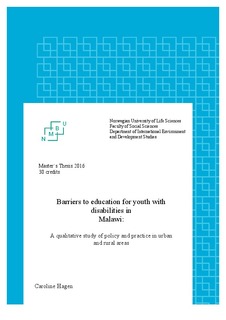| dc.description.abstract | Youth with disabilities in Malawi constitute a minority group that is particularly vulnerable to social exclusion and lack of education. The aim of this study is to carry out an in-depth exploration of barriers to education for youth with disabilities in Malawi. The objectives are: to identify relevant policies and actors at national, district and local level; to explore the situation in practice for youth with disabilities regarding education; and finally to explore possible differences between urban and rural areas. This research was conducted in two different geographical areas in Malawi: urban Lilongwe in the Central Region and rural Zomba in the Southern Region. Data collection was conducted between July and December 2015. The study offers a qualitative approach to the subject, being based on a series of in-depth, semi-structured interviews. To explore barriers and facilitators to education in the respective areas, ten youths with disabilities were interviewed as case studies, in addition to their families, service providers and contextual informants. Two different translators were used, one in each of the two geographical areas.
Findings reveal that although Malawi´s policies and legal framework towards disability and education are adequate, these are not implemented in practice. Barriers to education are many. These include the way special needs are organised in the respective areas; little or no attention from teachers; stigmatization; lack of support and knowledge from home and the community; physical obstacles; lack of human and material resources; and poverty. Although the urban and rural areas in this study differ in the way special needs are organised, the poor economic situation of Malawi results in few and inadequate resources for youth with special needs in both areas. Consequences of these barriers include early dropouts and/or continuous repeating of levels. | nb_NO |
